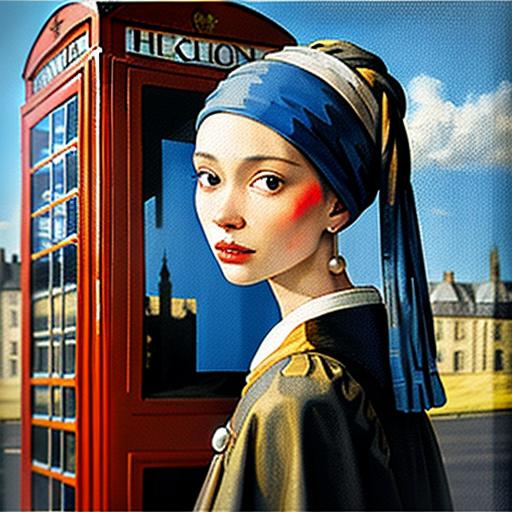The image of the solitary artist working alone in a dimly lit studio has captivated our imagination for centuries. This “lonely artist myth” suggests that true artistic genius emerges only through isolation, away from society’s distractions. But is this romantic notion accurate? Throughout history, artists have actually balanced periods of solitude with active engagement in vibrant communities. This balance between withdrawal and connection reveals a more nuanced reality about how creativity truly flourishes.
Key Points:
- The lonely artist myth romanticizes isolation as essential for creativity
- Historical evidence shows most artists balanced solitude with community
- Artistic breakthroughs often happen through collaboration, not isolation
- Digital technology has transformed how artists experience solitude
- Finding personal balance between focus and connection benefits creativity
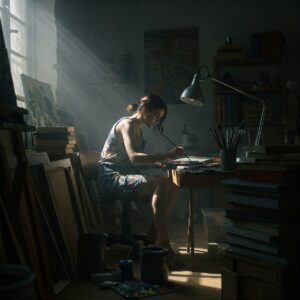
Origins of the Lonely Artist Myth
The idea that artists must work in isolation has deep historical roots. It began during the Renaissance when writers like Giorgio Vasari portrayed artists as special individuals living on society’s edges. His influential 1550 book, “The Lives of the Artists,” helped establish this narrative.
The myth gained momentum through romanticized stories of artists who seemed to fit this ideal. Vincent van Gogh stands as the quintessential example, often portrayed as the “poster boy for the tortured, isolated, ignored artist.” His move from Paris to Arles is frequently interpreted as rejecting social circles for isolation. Van Gogh claimed this withdrawal helped him “see things more clearly.”
Popular culture continues reinforcing this stereotype through movies, books, and media that glorify the struggling, solitary artist. These portrayals emphasize emotional turmoil while ignoring the disciplined, collaborative aspects of creative work.
Historical Context
The lonely artist myth developed alongside broader cultural shifts. During the Romantic period (late 18th and early 19th centuries), increased emphasis on individualism and emotional expression strengthened the connection between artistic genius and solitary contemplation.
By the 20th century, the myth had become so entrenched that some artists deliberately embraced isolation as part of their artistic identity. The myth became self-reinforcing—artists performed the role expected of them by critics and the public who had internalized these romantic notions.
Famous Artists and Their Relationship with Isolation
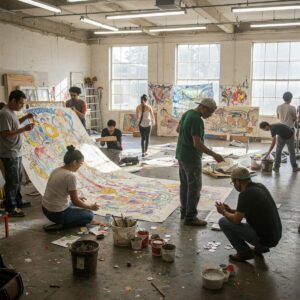
Throughout history, many artists have engaged with isolation in various ways, both embracing and rejecting solitude as part of their creative process.
Renaissance artist Giorgio Vasari periodically retreated to a monastery in rural Tuscany where, as he wrote, “I could have found no better place to know myself.” These voluntary withdrawals gave him space for creation away from the “rumors, bureaucracy, and general ‘noise’ of life.” For Vasari, isolation served as a temporary retreat rather than a permanent lifestyle.
Vincent van Gogh’s relationship with isolation was more complex. While often portrayed as the archetypal isolated genius, the reality reveals the importance of artistic exchange. Van Gogh’s artistic breakthrough in Arles actually coincided with Paul Gauguin’s visit, showing that interaction with another artist stimulated rather than hindered his creativity. Their joint work period led to significant developments for both artists, even though their relationship eventually deteriorated.
In the 20th century, some artists incorporated isolation directly into their work. Performance artist Chris Burden created “Bed Piece” (1972), in which he lay in a bed inside a gallery in complete self-imposed isolation for three months. These works transformed isolation from a working method into the subject of art itself.
Table: Artists Associated with the Lonely Artist Myth
| Name | Art Form | Era/Period | Reason for Association |
|---|---|---|---|
| Vincent van Gogh | Painter | Post-Impressionism | Known for his mental health struggles, self-imposed isolation, and lack of recognition during his lifetime. |
| Emily Dickinson | Poet | 19th Century | Lived a reclusive life, rarely leaving her home, and only gained fame posthumously. |
| Sylvia Plath | Poet/Writer | 20th Century | Struggled with depression and societal expectations; her semi-autobiographical works reflect isolation. |
| Edgar Allan Poe | Writer/Poet | Romanticism | Often depicted as a tormented soul whose dark themes mirrored his personal struggles and loneliness. |
| Frida Kahlo | Painter | Modern Art | Suffered physical pain and emotional turmoil; used art to express her inner world while feeling alienated. |
| Ludwig van Beethoven | Composer | Classical/Romantic | Dealt with progressive hearing loss, leading to social withdrawal and intense focus on his music. |
| Jackson Pollock | Painter | Abstract Expressionism | Struggled with alcoholism, mood swings, and societal misunderstanding of his innovative techniques. |
| Kurt Cobain | Musician | Grunge Era (1990s) | Battled addiction and fame-induced alienation; lyrics often reflected feelings of loneliness and despair. |
| Georgia O’Keeffe | Painter | Modern Art | Spent much of her career living in remote areas, focusing intensely on her art and nature. |
| Franz Kafka | Writer | Early 20th Century | Worked in obscurity during his lifetime; themes of alienation and existential dread permeate his writing. |
| Billie Holiday | Singer | Jazz Era (Mid-20th C) | Faced racism, exploitation, and personal hardships; her haunting voice conveyed deep sorrow and loneliness. |
| Michelangelo | Sculptor/Painter | Renaissance | Often worked alone for long periods; clashed with patrons and society over creative control. |
| Anne Sexton | Poet | Confessional Poetry | Openly discussed mental illness and suicide in her work; felt deeply disconnected from conventional life. |
| Jean-Michel Basquiat | Painter | Neo-Expressionism | Rose quickly to fame but faced racism, substance abuse issues, and feelings of being an outsider. |
| Virginia Woolf | Writer | Modernism | Struggled with bipolar disorder and societal constraints on women; explored themes of isolation in her work. |
| Modigliani | Painter/Sculptor | Modern Art | Lived a bohemian lifestyle marked by poverty, illness, and rejection by mainstream audiences. |
| Amy Winehouse | Singer/Songwriter | Contemporary Pop/Jazz | Publicly battled addiction and fame-induced pressures; her lyrics frequently expressed heartbreak and loneliness. |
| Mary Shelley | Writer | Romanticism | WroteFrankensteinpartly out of grief and isolation after losing loved ones; marginalized as a female writer. |
| David Foster Wallace | Writer | Postmodern Literature | Struggled with depression and anxiety; wrote extensively about isolation and modern alienation. |
| Mark Rothko | Painter | Abstract Expressionism | Committed suicide amid declining health and critical backlash; his later works evoke profound melancholy. |
The Reality: Balancing Solitude and Connection
The lived experience of most successful artists reveals a more nuanced reality than the myth suggests. Rather than existing in perpetual isolation, most navigate a dynamic balance between periods of solitude and social engagement.
“It is a constant dance for artists between isolation and social interaction. When there is too much ‘real life’ it feels like interference and we long for alone time to get our work done. But simply being alone with our work can lead to stale repetitions.”
Immersion and temporary isolation can benefit artists completing substantial projects that require deep focus. Many find that removed from everyday distractions, they can devote extended periods to developing their ideas. Writer Haruki Murakami described his self-imposed isolation as helping him achieve a state of being “continuously mesmerized”—a beneficial mental state for creative productivity.
However, evidence suggests that breakthrough moments often occur not during intense isolation but when artists step away from their work and engage with the world. Creative blocks are frequently resolved through “an unplanned deviation, an unexpected binge, a love affair or just a coffee in a new place.” These observations challenge the notion that isolation alone produces great art.
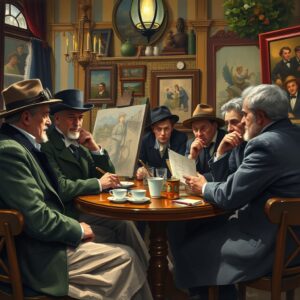
Collaboration as Creative Catalyst
Contrary to the stereotype of the solitary genius, collaboration has proven essential to the development of many artistic movements and individual careers. The reality is that “artists who come up together tend to make a larger splash in the art market than artists who attempt to go it alone.” Having a supportive network provides both emotional support and professional opportunities.
Historical artistic movements—from the Impressionists to the Surrealists to the Abstract Expressionists—emerged not from isolated individuals but from communities of artists engaging in ongoing dialogue, critique, and mutual inspiration. Even artists who seemingly worked alone often maintained active correspondence with fellow creators and participated in exhibitions.
Psychological Impact of the Lonely Artist Myth
The belief that artists must be isolated to create meaningful work carries significant psychological consequences. For established artists, the expectation of isolation can lead to actual loneliness, which has been identified as “an industry hazard for fine artists.” The romantic idealization of solitude masks the very real mental health challenges that can accompany extended periods of isolation.
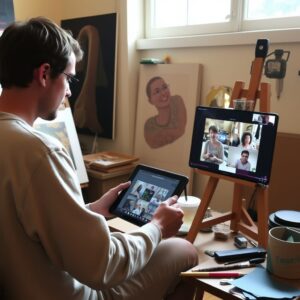
For aspiring artists, the myth creates unnecessary pressure to adopt a lifestyle that may not suit their temperament or creative process. Many emerging creators feel inadequate if they thrive in collaborative environments or need regular social interaction to maintain emotional well-being. This disconnect between expectation and personal need can lead to impostor syndrome—the feeling that one isn’t a “real artist” because one’s process doesn’t match the mythologized ideal.
The psychological impact extends beyond individual artists to influence broader cultural attitudes about creativity and mental health. The related “mad artist” myth suggests that “artists must be mentally unstable to be creative,” linking artistic ability with psychological suffering. This harmful misconception glorifies mental illness when in reality, “many artists have created their best works during periods of stability and happiness in their lives.”
Artists in the Digital Age: New Forms of Connection
The digital age has transformed how artists negotiate isolation and connection. Social media platforms allow creators to share work instantly with global audiences while physically working alone. Online communities provide critique, inspiration, and professional opportunities without requiring geographic proximity.
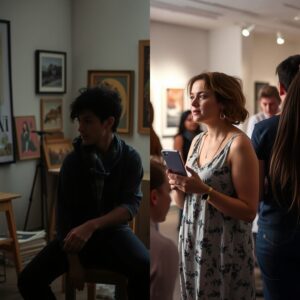
During the COVID-19 pandemic, when many experienced forced isolation, the myth of the solitary artist was tested in unprecedented ways. Many creators reported that while they previously enjoyed occasional solitude for work, extended isolation proved detrimental to their creative process. This widespread experience prompted further questioning of romanticized notions about artistic seclusion.
Practical Tips for Artists: Finding Your Balance
Every artist needs to find their own balance between solitude and connection. Here are some practical suggestions:
- Schedule focused work time: Create dedicated periods for uninterrupted creation, but limit their duration
- Join artist communities: Participate in local or online groups where you can share ideas and receive feedback
- Collaborate on projects: Work with other artists to expand your perspective and techniques
- Attend exhibitions and events: Expose yourself to new ideas while connecting with other creators
- Use social media mindfully: Build connections online without letting it distract from your creative practice
- Create a dedicated workspace: Having a specific area for your art helps focus without complete isolation
- Listen to your needs: Pay attention to when you need solitude and when you need connection
Conclusion: Beyond the Lonely Artist Myth
The lonely artist myth represents one of our culture’s most persistent stereotypes about creativity, yet examination reveals it to be a significant oversimplification. While periods of solitude can provide valuable space for focused creation, evidence suggests most artists benefit from a dynamic balance between withdrawal and engagement. The myth’s emphasis on permanent isolation disregards the crucial role of collaboration, community, and social exchange in fostering innovation.
For individual artists navigating their creative lives, recognizing the limitations of the lonely artist myth offers liberation from unnecessary constraints. Creators can design personalized approaches to managing solitude and connection based on their unique temperaments and the specific demands of their work. This more nuanced understanding allows artists to seek the support they need without feeling they have betrayed some essential principle of artistic authenticity.
Ultimately, great art emerges not from perpetual isolation but from a thoughtful negotiation between solitude and connection, individual vision and shared cultural conversation. By understanding the truth behind the lonely artist myth, we can better support creativity in all its forms.
FAQ: The Lonely Artist Myth
Are all great artists loners?
No, most great artists throughout history maintained important connections with other artists, mentors, and communities. While they may have had periods of focused solitude, few were truly isolated. Many famous artistic movements emerged from groups of artists working together and inspiring each other.
How does isolation affect creative work?
Brief periods of isolation can help artists focus deeply on their work without distraction. However, extended isolation often leads to stagnation rather than innovation. Most artists find they need both quiet time for creation and social interaction for inspiration and feedback.
What are the benefits of collaboration in art?
Collaboration provides fresh perspectives, technical cross-pollination, emotional support, and professional opportunities. Artists working together often challenge each other to grow beyond their comfortable patterns and develop new approaches to their work.
Is the “tortured artist” stereotype accurate?
The stereotype that links artistic ability with psychological suffering is largely a myth. Many artists have created their best work during periods of stability and happiness. While some artists have struggled with mental health issues, this is not a prerequisite for creativity.
How has social media impacted artist isolation?
Social media has created new possibilities for artists to connect while physically working alone. Online communities provide critique, inspiration, and professional opportunities without requiring geographic proximity. This has transformed the traditional dynamics of artistic isolation.
External Resources:



